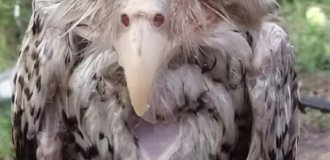Crane Hawk: Here We Have a Principled Hole-Breaker (9 photos)
In order to survive, these birds are forced to wander the world their entire lives and stick their paws into all sorts of dubious holes. 
Well, it's time to inspect your hollow.
The crane hawk is a small bird of prey the size of a pigeon. They have nothing to do with ordinary cranes, they just have paws like first-class models - that's why biologists didn't bother with the name. 
What will make my beautiful legs stand out against the background of a gray appearance? That's right, bright red boots!
Adult crane hawks grow only 22 centimeters in length from their sharp beak to the tip of their tail. They weigh from 250 to 500 grams - their dimensions are slightly larger than those of the smallest representative of the family, the sparrowhawk. "We can't beat other birds in strength or speed, so let's use cunning!" - the cranes decided and came up with the most unusual way of hunting in the entire bird kingdom. 
According to the documents - a hawk, by name - a crane, in fact - a peacock.
All day long the birds fly from tree to tree, roam the ground and search the banks of local reservoirs. What are they looking for? Actually, dubious holes! This could be an old hollow, a crack in the bark, someone's hole, a crevice in the rock, a depression between stones and all that sort of thing. 
I'm not a drug addict! I'm just driving and looking, calm down!
And when a suitable hole is found, the cranes quickly stick their long legs in there - suddenly someone is hiding there! If the size allows, the hawks will stick their head in, just to be sure. It looks about the same as when we try to get some small thing from under the couch. 
Yes, it's convenient for me. Instead of laughing and filming, it would be better to help!
It turned out that this strategy is more than effective! Usually, there are a lot of different animals sitting in burrows and hollows. Frogs, bats and walking mice, lizards, small mammals and large insects. Sometimes, someone's eggs or chicks lie in such secluded places. 
Crane hawks hunt more than 100 types of prey. But most often, their victims are small rodents.
And most importantly, crane hawks have no feathered competitors! Only two species hunt in this unconventional way: our heroes and African harrier hawks. And since cranes live in both Americas, an entire ocean away from the Africans, all the prey in the holes is only for them! 
When you first go to your university and have no idea where room 321b is.
To probe the holes more conveniently, the birds have learned to bend their legs in both directions. All thanks to the unique structure of the tibia and tarsus. The tibia is the part that you bake in the oven. The tarsus is the bare part of the bird's leg. They are connected by a very mobile double joint. With its help, the hawk's leg bends both forward and 30⁰ backward. 
I wouldn't go to such a stretching teacher...
Thanks to such a unique probing method of hunting, crane hawks were able to populate almost all possible habitats in their region. They live in forests, swamps, and even on coffee plantations. And, unlike many other birds, our birds don't even have to migrate anywhere! No matter how well the food is hidden, the golden-footed bird will get it everywhere! 
Whoever didn't hide, it's not my fault!
But what their hunting preferences did not affect was reproduction. Cranes honor the traditions of the hawk family: a pair builds a nest together, hatches the chicks together and then looks after them. Usually, hawks lay only 1-2 eggs in a clutch; a family cannot handle more babies even with all the skill in getting food. This is because the hawks develop slowly. They spend a month in the egg, and another month - they sit completely on their parents' necks. Then the overgrown birds try to hunt on their own, but their caring ancestors continue to feed them anyway.



























